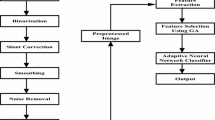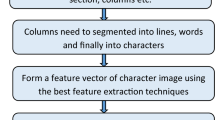Abstract
In this paper two level model of handwritten word recognition is considered. On the first level the consecutive letters are recognized by the same classifier using preprocessed data from the optical device, while on the second level we try to recognize the whole word. From the other point of view we can treat the first level as a feature reduction level. Then, in this paper two different methods of feature reduction for handwritten word recognition algorithm are described. On the lower level different well-known in the literature methods are taken into account (for example multi layer perceptron, k-NN algorithm). The results of classification from the first level serve as a feature for the second level and two different cases are considered. The first one consist in taking into account the crisp result of classification from the first level while in the second approach we take into account the support vector of decision on this level. On the second level, in order to improve the word recognition accuracy, for both methods, the Probabilistic Character Level Language Model was applied. In this model, the assumption of first-order Markov dependence in the sequence of characters was made. Moreover, we comment the possibility of using Markov model in forward and backward directions. For both methods of feature reduction the appropriate word recognition algorithms are presented. In order to find the best solution, the Viterbi algorithm is used. A number of experiments were carried out to test the properties of the proposed methods of feature reduction. The experiment results are presented and concluded in the end of the paper.
Preview
Unable to display preview. Download preview PDF.
Similar content being viewed by others
References
Brakensiek, A., Rottland, J., Kosmala, A., Rigoll, G.: Off-Line Handwriting Recognition Using Various Hybrid Modeling Techniques and Character N-Grams. In: Proc. of the Seventh Int. Workshop on Frontiers in Handwriting Recognition, pp. 343–352 (2000)
Duda, R.O., Hart, P.E., Stork, D.G.: Pattern Classification, 2nd edn. Combining Classifiers: Soft Computing Solutions. John Wiley & Sons, Chichester
Kuncheva, L.: Combining Classifiers: Soft Computing Solutions. In: Pal, S., Pal, A. (eds.) Pattern Recognition: from Classical to Modern Approaches, pp. 427–451. World Scientific, Singapore (2001)
Marti, U.V., Bunke, H.: Using a Statistical Language Model to Improve the Performance of an HMM-Based Cursive Handwritting Recognition System. Int. Journ. of Pattern Recognition and Artificial Intelligence 15, 65–90 (2001)
Liu, C., Nakashima, K., Sako, H.: Handwritten Digit Recognition: Benchmarking of State-of-the-Art Techniques. Pattern Recognition 36, 2271–2285 (2003)
l-Nasan, A., Nagy, G., Veeramachaneni, S.: Handwriting recognition using position sensitive n-gram matching. In: Proc. 7th Int. Conf. on Document Analysis and Recognition, pp. 577–582 (2003)
Vinciarelli, A., Bengio, S., Bunke, H.: Offline Recognition of Unconstrained Handwritten Text Using HMMs and Statistical Language Models. IEEE Trans. on PAMI 26, 709–720 (2004)
Sas, J., Luzyna, M.: Combining Character Classifier Using Member Classifiers Assessment. In: Proc. of 5th Int. Conf. on Intelligent Systems Design and Applications, ISDA 2005, pp. 400–405. IEEE Press, Los Alamitos (2005)
Sas, J.: Application of Bidirectional Probabilistic Character Language Model in Handwritten Words Recognition. In: Corchado, E.S., Yin, H., Botti, V., Fyfe, C. (eds.) IDEAL 2006. LNCS, vol. 4224, pp. 679–687. Springer, Heidelberg (2006)
Sas, J.: Handwritten Text Recognition Using Incomplete Probabilistic Lexicon and Character Language Model. Systems Science 32(2), 45–61 (2006)
Sas, J., Zolnierek, A.: Handwritten Word recognition with Combined Classifier Based on Tri-grams. In: Kurzynski, M., et al. (eds.) Advances in Soft Computing. Computer Recognition Systems 2, vol. 45, pp. 477–484. Springer, Heidelberg (2007)
Author information
Authors and Affiliations
Editor information
Rights and permissions
Copyright information
© 2008 Springer-Verlag Berlin Heidelberg
About this paper
Cite this paper
Sas, J., Zolnierek, A. (2008). Comparison of Feature Reduction Methods in the Text Recognition Task. In: Rutkowski, L., Tadeusiewicz, R., Zadeh, L.A., Zurada, J.M. (eds) Artificial Intelligence and Soft Computing – ICAISC 2008. ICAISC 2008. Lecture Notes in Computer Science(), vol 5097. Springer, Berlin, Heidelberg. https://doi.org/10.1007/978-3-540-69731-2_70
Download citation
DOI: https://doi.org/10.1007/978-3-540-69731-2_70
Publisher Name: Springer, Berlin, Heidelberg
Print ISBN: 978-3-540-69572-1
Online ISBN: 978-3-540-69731-2
eBook Packages: Computer ScienceComputer Science (R0)




